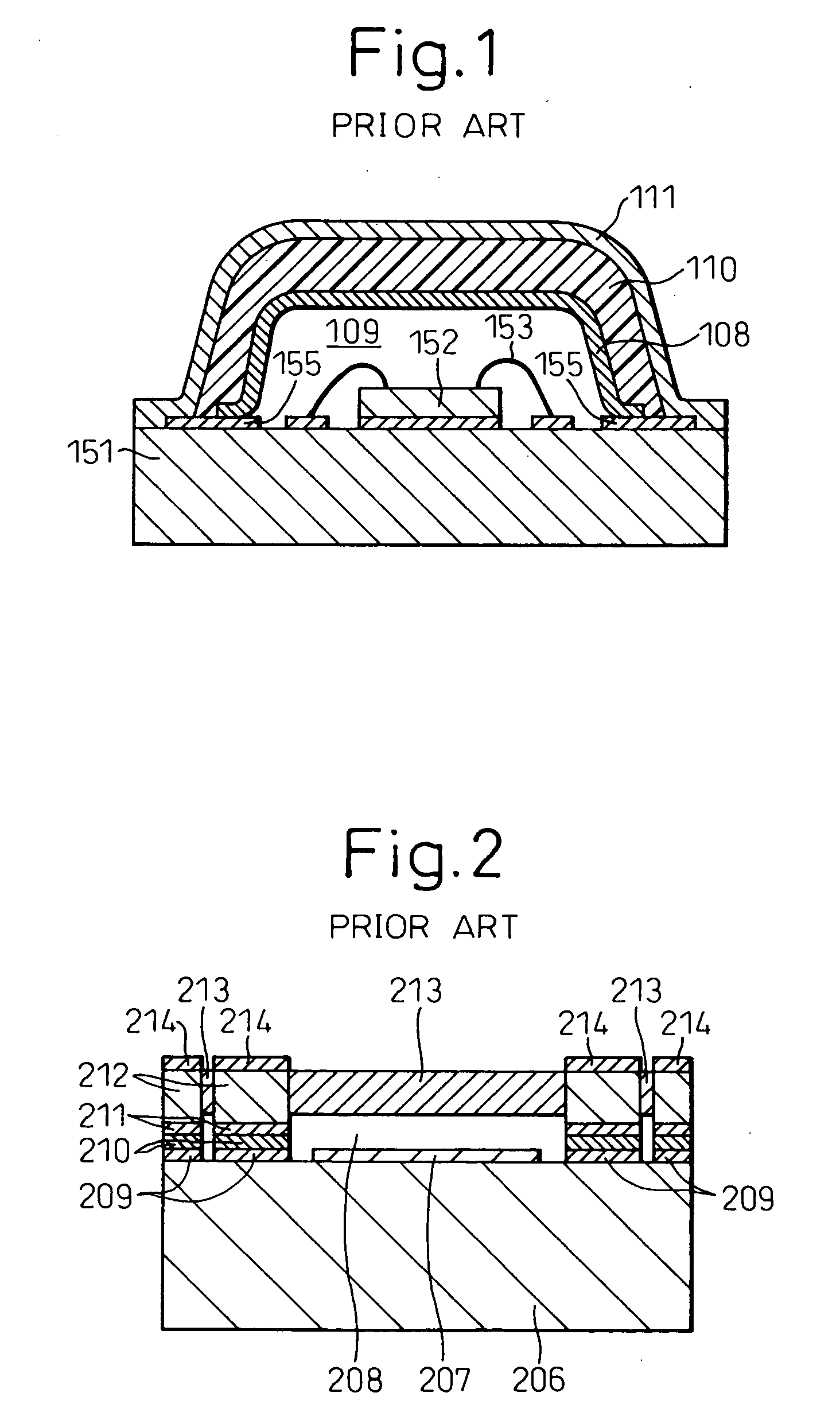Electronic devices and its production methods
- Summary
- Abstract
- Description
- Claims
- Application Information
AI Technical Summary
Benefits of technology
Problems solved by technology
Method used
Image
Examples
example 1
[0138] In this example, a suitable method of production of the MEMS element mounting electronic device shown in FIG. 3 will be explained with reference to FIGS. 11A to 11M.
[0139] First, as shown in FIG. 11A, a silicon wafer 2 is prepared and is washed and dried to remove dirt and the like from the wafer surface.
[0140] Next, as shown in FIG. 11B, a photoresist 21 is coated at a predetermined thickness on one surface of the silicon wafer 2 and patterned to match with the cavity and through holes to be formed. The obtained resist pattern 21 is used as a mask to etch the underlying silicon wafer 2, thereby forming the cavity 12 and through holes (not yet completely opened) 24.
[0141] Here, the silicon wafer may be etched using various methods. For example, plasma etching, sputter etching, reactive ion etching, and other dry etching processes or wet etching processes using an etching solution may be used. In the case of plasma etching, for example, CF4, SF6 and the like may be used as ...
example 2
[0154] In this example, a suitable method for producing an MEMS element mounting electronic device explained in FIG. 5 in accordance with the technique described in Example 1 will be explained with reference to FIGS. 13A to 13D.
[0155] In this example, in addition to forming the copper wiring patterns 26 and the gold stud bumps 27 in accordance with the manner described in Example 1, as shown in FIG. 13A, a frame-like sealing pattern (seal ring) 46 is formed by copper electroplating on one surface (side to be bonded with MEMS substrate) of the circuit substrate 20, then a plating layer (for example, tin plating, gold plating and the like) 47 is formed over that. Note that in place of gold stud bumps 27, it is also possible to form bumps by gold plating at the same time as forming the plating layer 47.
[0156] In addition to the circuit substrate 20, the MEMS substrate 1 is also subjected to similar treatment. That is, as shown in FIG. 13B, in addition to forming the Al electrodes 31 ...
example 3
[0160] In this example, a modification of an MEMS element mounting electronic device shown in FIG. 3 and a preferred production method of the same will be explained with reference to FIGS. 14A to 14C. Using the production method described in this example, it is possible to provide an electronic device with a greater number of functions by building a semiconductor circuit into a silicon wafer or forming a capacitor, resistor, or other passive elements by a thin-film formation process and the like. Further, in this example, a silicon wafer is used, but, needless to say, it is possible to use a glass substrate or other substrate instead of the silicon wafer.
[0161] As shown in FIG. 14A, a silicon wafer 2 is prepared and a semiconductor circuits 28 are fabricated into its back surface (back surface of cavity-forming side). Next, as shown in FIG. 14B, a photoresist 21 is coated at a predetermined thickness on one surface of the silicon wafer 2 and is patterned in accordance with the cavi...
PUM
| Property | Measurement | Unit |
|---|---|---|
| Thickness | aaaaa | aaaaa |
Abstract
Description
Claims
Application Information
 Login to View More
Login to View More - R&D
- Intellectual Property
- Life Sciences
- Materials
- Tech Scout
- Unparalleled Data Quality
- Higher Quality Content
- 60% Fewer Hallucinations
Browse by: Latest US Patents, China's latest patents, Technical Efficacy Thesaurus, Application Domain, Technology Topic, Popular Technical Reports.
© 2025 PatSnap. All rights reserved.Legal|Privacy policy|Modern Slavery Act Transparency Statement|Sitemap|About US| Contact US: help@patsnap.com



